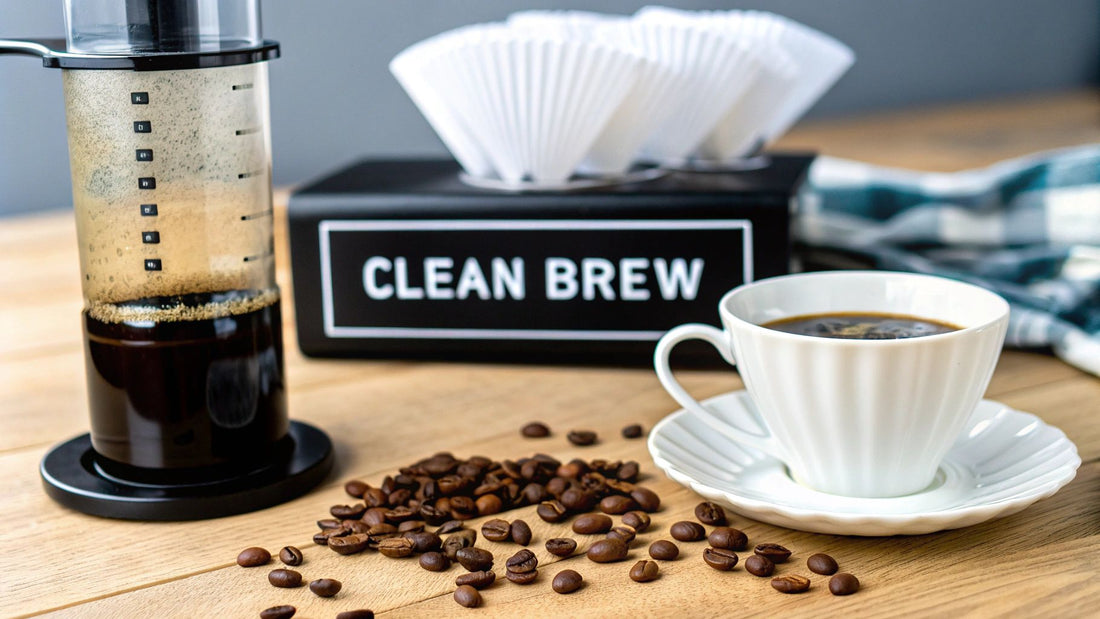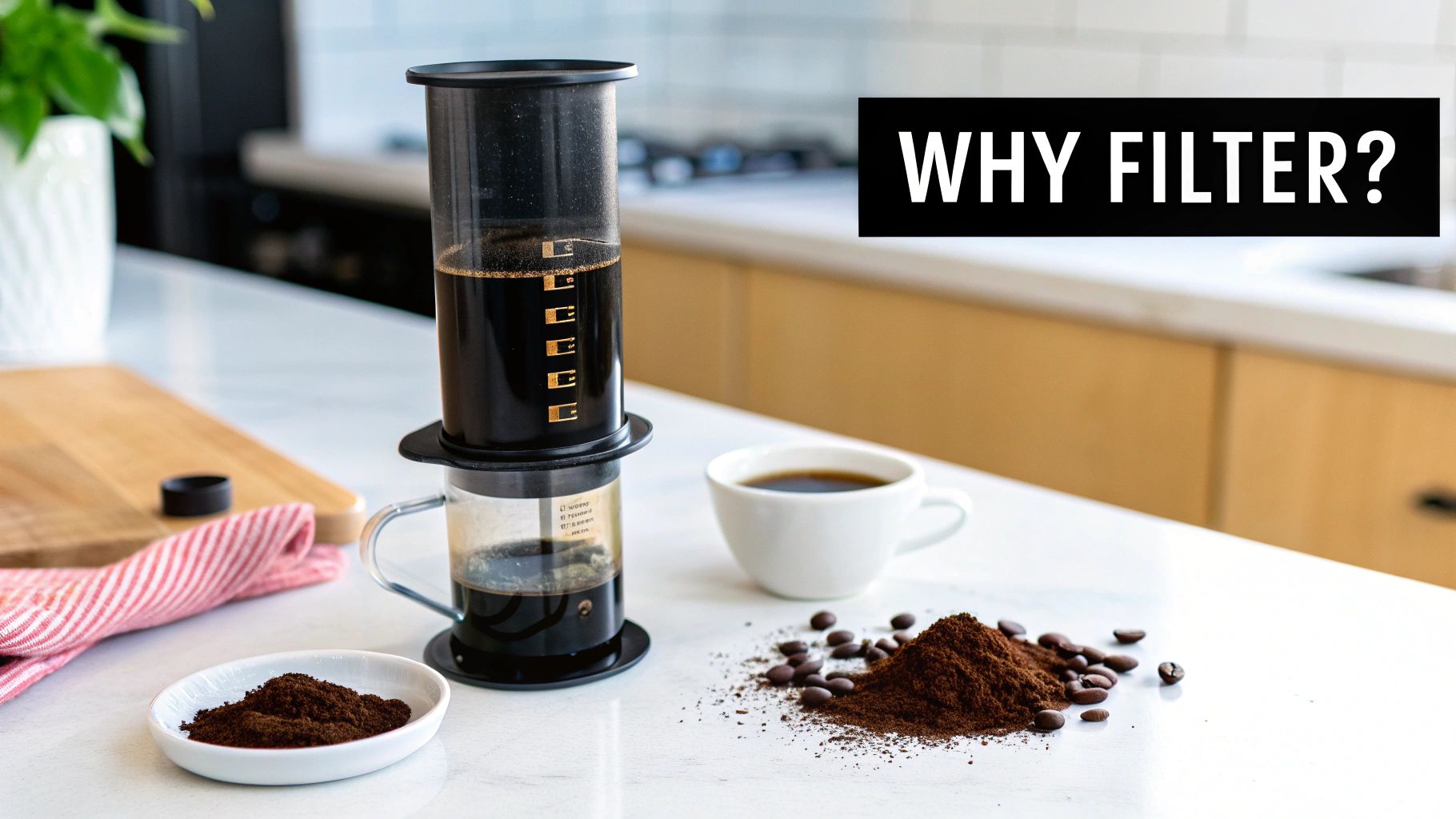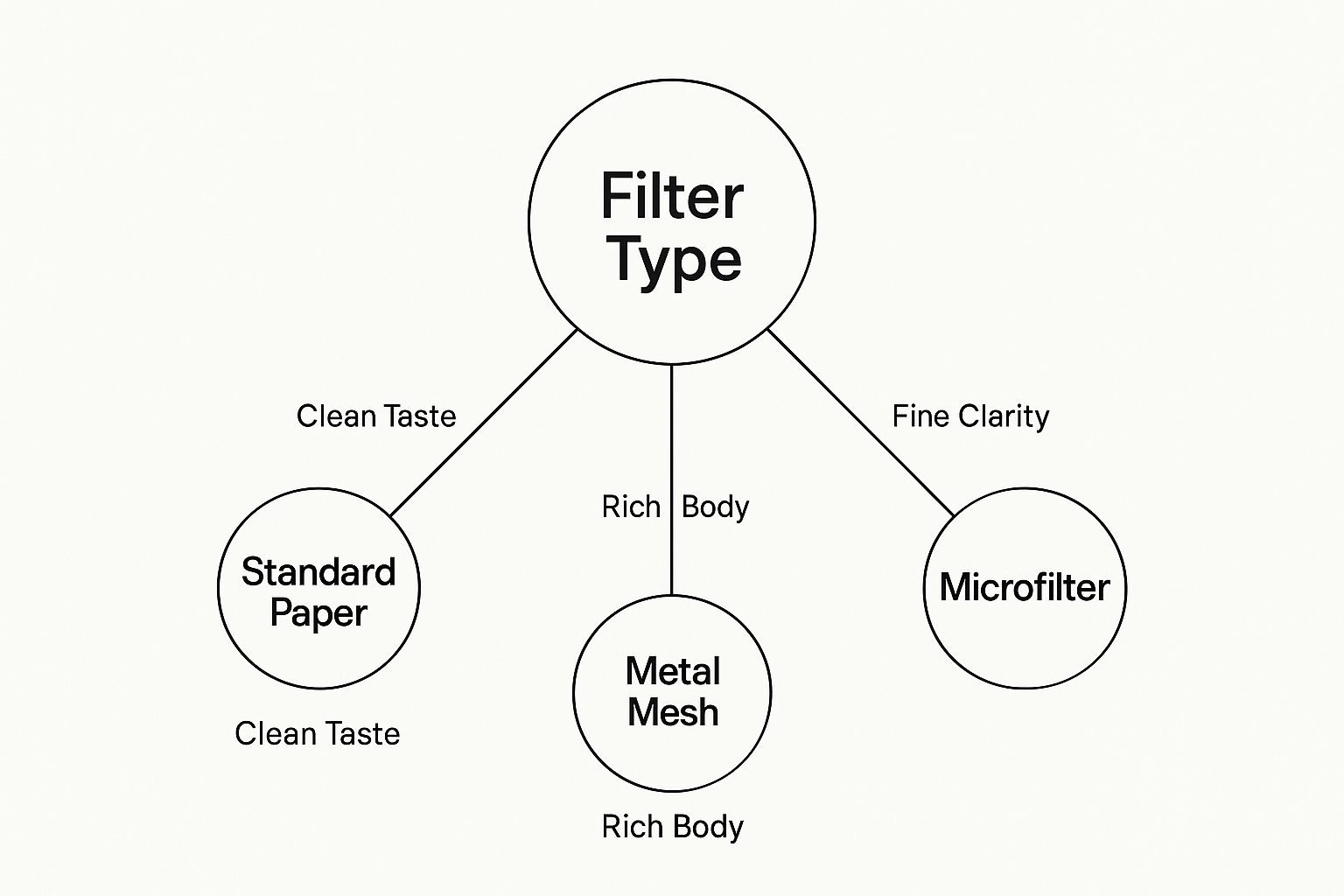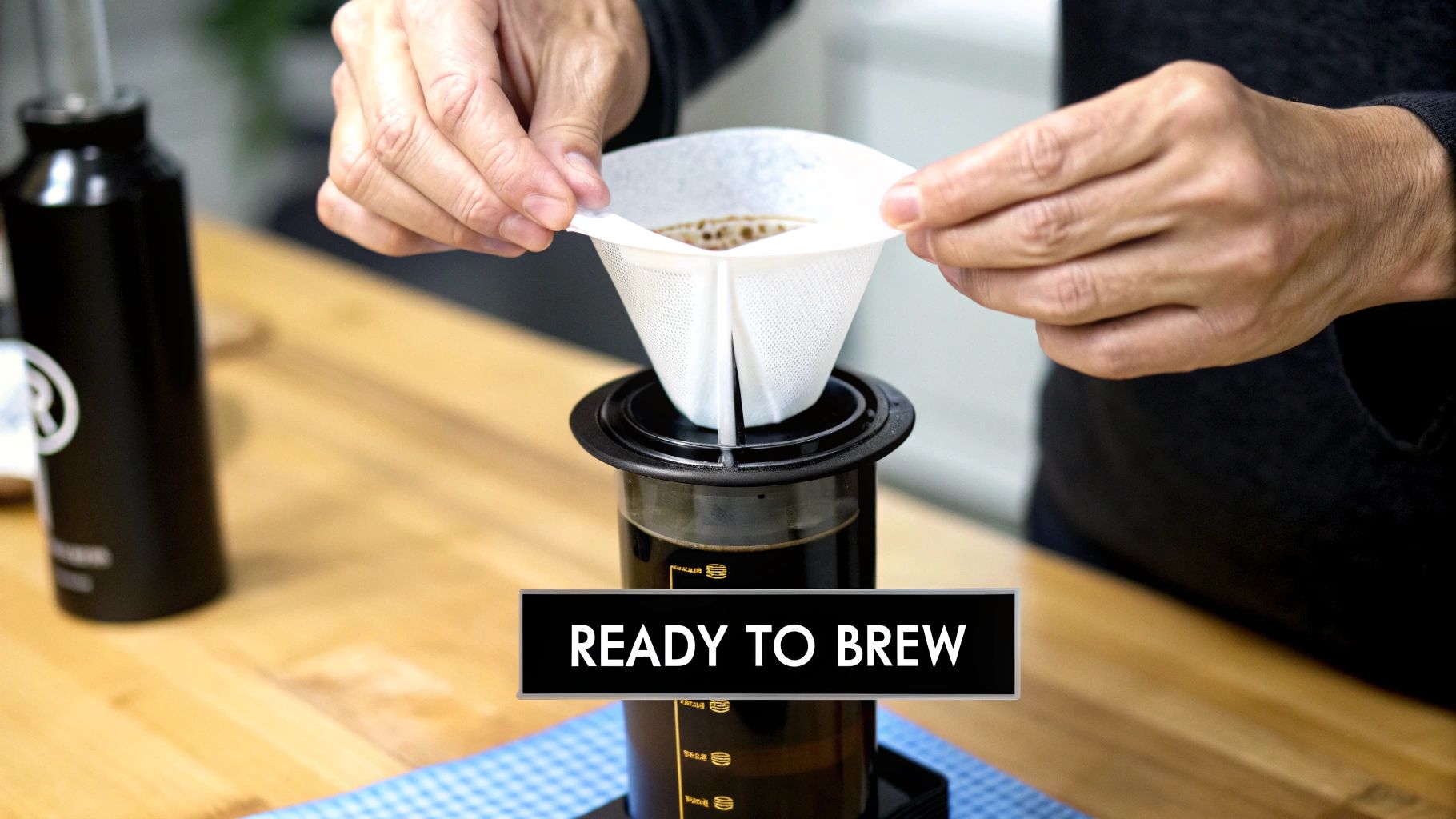
Your Guide to AeroPress Filter Paper
Share
When you picture that perfect cup of coffee—clean, vibrant, and packed with flavour—what comes to mind? For many of us, the secret isn't in some grand gesture, but in a tiny, often overlooked detail: the AeroPress filter paper. This humble paper disc is an essential part of any UK home barista's kit, standing as the final gatekeeper between your coffee grounds and your cup.
The Secret to a Cleaner, Richer Brew

For anyone dedicated to getting the absolute best out of their speciality beans, the filter is where the real magic happens. It’s so much more than a simple barrier; it’s an active participant that directly shapes the final taste and texture of your coffee.
Think of it as the curator of your brew. Its most basic job is to stop coffee grounds from ending up in your mug, while letting all those delicious, water-soluble flavour compounds pass right through. But its influence runs much deeper than just that.
The right filter doesn’t just prevent sludge; it shapes the entire sensory experience. By controlling which oils and micro-particles enter the cup, it defines the coffee's body, clarity, and aromatic profile.
It’s time to stop seeing your filter as a disposable afterthought and start treating it as a fundamental step towards a truly exceptional cup. Understanding its role is the key to unlocking the full potential of your AeroPress, letting all the nuanced notes of high-quality, UK-roasted coffee shine through. Let's explore how this simple paper circle can elevate your daily ritual from merely good to genuinely extraordinary.
Choosing Your Ideal AeroPress Filter
When it comes to your AeroPress, the filter you choose isn’t just a minor detail—it completely shapes the coffee in your cup. Think of it like a camera lens: some give you a super sharp, clear picture, while others create a softer, richer focus. For any coffee lover in the UK, getting to grips with your filter options is the first real step to mastering this brilliant brewer.
The journey usually starts with the classic AeroPress filter paper. There’s a good reason these are the standard—they’re famous for producing an incredibly clean, crisp cup. Within this family, you’ll find both bleached and unbleached options. The bleached ones use an oxygen-based process to turn them white, making them completely neutral in flavour. This is perfect for letting the delicate, nuanced notes of a single-origin bean really sing.
Unbleached filters, on the other hand, have a more natural look but can sometimes leave a subtle papery taste behind if you don't give them a good rinse before brewing. It’s a small step that makes a big difference.
Then you have the reusable metal filters, which offer a totally different experience. These are typically made from fine stainless steel mesh and they allow more of the coffee's natural oils and tiny particles (often called micro-fines) to pass through into your brew. The result? A coffee with a much fuller body, a richer texture, and a flavour profile that feels closer to a cafetière. If you love a bolder, more robust cup, this is a fantastic route to take.
This simple diagram really nails the trade-off you’re making.

As you can see, it’s a direct choice between body and clarity. This should get you thinking about what you want from your coffee and which filter will help you get there.
AeroPress Filter Comparison: Paper vs Metal
To make the choice a bit clearer, let's break down the key differences between standard paper filters and their reusable metal counterparts. This table lays out what you can expect from each, helping you decide which one best fits your daily brewing ritual and taste preferences.
| Characteristic | Paper Filter (Standard) | Metal Filter (Reusable) |
|---|---|---|
| Cup Clarity | Very high; clean and crisp | Lower; some fine sediment |
| Body & Texture | Light-bodied and smooth | Full-bodied and rich |
| Flavour Profile | Bright, highlights acidity and delicate notes | Muted acidity, enhances deeper, bolder notes |
| Oils in Cup | Absorbs most oils | Allows oils to pass through |
| Ease of Use | Simple, disposable, easy cleanup | Requires rinsing and occasional deep cleaning |
| Cost | Low initial cost, ongoing expense | Higher initial cost, no recurring expense |
| Sustainability | Single-use (though compostable) | Highly reusable, lasts for years |
Ultimately, both paper and metal filters have their place in a coffee lover's toolkit. Your choice will likely depend on the type of coffee you're brewing and the specific characteristics you want to highlight in the final cup.
So, Paper or Metal? Which Is Right for You?
The decision really boils down to your personal taste and the kind of coffee you're excited to brew.
Here's a simple way to think about it:
- Choose Paper for Clarity: If you're brewing a complex, light-roast speciality coffee from a great UK roaster and want to taste every single floral or fruity note, paper is your best friend. It creates that clean canvas you need for those delicate flavours to pop.
- Choose Metal for Body: If you're someone who craves a richer, more intense coffee experience, maybe with a darker roast, a metal filter is going to deliver that deeply satisfying, full-bodied cup you’re looking for.
Why Paper Filters Elevate Your Coffee

So, what makes paper the champion’s choice for so many UK baristas and home coffee lovers? It all boils down to one simple word: clarity. A good quality AeroPress filter paper is your direct ticket to an exceptionally clean and vibrant cup, turning your daily brew into something genuinely special.
The magic is in the design. The paper's dense network of fibres is brilliant at trapping two things that can otherwise cloud your coffee’s flavour: excess oils and micro-grounds, often called ‘fines’. If left to their own devices, these tiny sediment particles create a silty texture and a muddy, sometimes bitter taste.
By getting rid of them, the paper filter delivers a brew with a crisp, clean finish. This is what allows the delicate and complex notes of a high-grade single-origin bean to really sing. Think of it as spring cleaning for your coffee—clearing away all the clutter so you can appreciate the intricate details hiding inside.
Consistency You Can Count On
Beyond just flavour, paper filters offer something every home brewer in the UK is looking for: reliability. Each paper disc is a fresh start, guaranteeing a consistent and repeatable brew every single time you press. You never have to worry about lingering oils or grounds from yesterday's coffee interfering with today's cup.
The greatest strength of paper is its ability to produce a 'clean cup' profile. This purity is essential for tasting the bright, acidic, and floral notes that the UK’s best speciality roasters work so hard to develop.
This level of consistency is absolutely key when you're trying to perfect your technique. It gives you a stable baseline, freeing you up to experiment with your grind size, water temperature, and brew time, all while knowing the filter is doing its job perfectly. For anyone serious about exploring the world of speciality coffee, the humble AeroPress paper filter is an indispensable tool for chasing that flawless brew.
Mastering Your Brew With Perfect Filter Technique

Having the right AeroPress filter paper is a great start, but knowing how to use it is what truly unlocks your coffee's potential. Turning a good brew into a masterpiece often comes down to those small, deliberate actions that elevate your technique from simply making coffee to crafting it with real intention.
Your journey to a better cup begins with a simple but crucial step: the pre-rinse. Before you even think about adding coffee, pop the paper filter into the cap and give it a thorough rinse with hot water for 5-10 seconds. This little trick does two things: it washes away any papery taste and helps the filter stick to the cap, creating a perfect seal that stops pesky grounds from sneaking through.
Getting the filter seated properly is just as important. Once it's rinsed, make sure it’s lying completely flat against the plastic cap, with no creases or folds. A wonky filter can create tiny channels for water to bypass the coffee, leading to a weak, uneven, and disappointing extraction.
Advanced Filter Techniques
Once you've got the basics down, you can start playing around with more advanced methods to really refine your brew. These are the kinds of techniques coffee pros and home enthusiasts across the UK use to dial in their desired flavour profile with incredible precision.
A popular method is double filtering. It’s exactly what it sounds like: using two paper filters stacked on top of each other.
- Why bother? The extra layer provides even finer filtration, trapping more of the oils and micro-grounds that can make a brew taste muddy.
- What's the result? An exceptionally clean, light-bodied cup with striking clarity. It’s perfect for showing off the delicate notes of a floral Ethiopian or a bright, zesty Kenyan coffee.
The real art of brewing is in matching your technique to your beans. A coarser grind might benefit from the extra security of a double filter, while a very fine grind for an espresso-style shot needs a perfectly seated single filter to handle the pressure.
Finally, think about how your filter and grind size work together. Using a high-quality AeroPress filter paper gives you a reliable, consistent starting point, which means you can adjust your grind with confidence. By experimenting with these small, simple steps, you'll gain complete control over your brew, turning every cup into a testament to your growing skill as a home barista.
The Rise of Conscious Coffee Consumption in the UK
The home brewing movement that’s taken hold across the UK is about so much more than just a better-tasting cup of coffee. It’s part of a much bigger shift towards a more thoughtful, conscious way of living. As brilliant, accessible bits of kit like the AeroPress become a fixture in British kitchens, our daily rituals are changing for the better. This is where the joy of speciality coffee at home meets the practicalities of a mindful lifestyle.
This new wave of conscious consumption shapes every little decision, right down to how we stock our cupboards. For the dedicated home barista, even buying a pack of AeroPress filter papers is a considered choice. Because they’re so affordable and easy to use, buying them in bulk just makes sense. A standard pack of 350 filters, for example, can see a daily coffee drinker through for three or four months, making it a simple, no-fuss part of the routine. You can find out more about how these filters fit into a sustainable lifestyle from insights on dustyape.com.
Sustainability in Every Sip
At its heart, this whole trend is powered by a real desire for sustainability. Coffee lovers across the UK are actively looking for products that match their environmental values, and the humble paper filter delivers on this front beautifully.
The fact that AeroPress paper filters are 100% biodegradable and compostable is a game-changer. It turns what could be a daily disposable item into a completely guilt-free part of an eco-conscious ritual.
Once you’ve pressed your brew, the filter and the used coffee grounds can go straight into the compost bin or food waste caddy. Instead of adding to landfill, they go back to enriching the soil. It’s a simple act that perfectly sums up the spirit of the modern UK coffee scene—where exceptional quality and environmental responsibility go hand in hand.
For those keen on expanding their eco-friendly brewing habits, you might also want to look into other sustainable brewing alternatives like reusable tea bags.
Why a Quality Filter is Here to Stay
That little paper disc at the bottom of your AeroPress? It might seem like a small detail, but it’s the unsung hero of the UK’s thriving home-brewing scene. As more of us get serious about making exceptional coffee at home, we’re realising that quality accessories are non-negotiable for getting consistent results. This isn't just a passing trend; it's a real shift in how we approach our daily brew.
The numbers back this up. The global market for coffee filter paper is set to grow significantly. What’s really telling is that household use is expected to make up more than 54.8% of that market. The home barista movement is officially a force to be reckoned with. You can dive deeper into these figures with this detailed market analysis at futuremarketinsights.com.
The Science Behind a Superior Sip
So, why all the fuss about a piece of paper? It all comes down to the science of its thickness, measured in GSM (grams per square metre). The AeroPress uses pressure to brew, which makes the filter’s job incredibly important. In the UK, filters in the 20 to 40 GSM range are king, capturing a significant portion of sales because they’ve nailed the perfect balance.
This specific thickness creates the ideal flow rate. It lets water pass through the coffee grounds evenly without getting stuck, but it's still dense enough to catch all the superfine sediment. The result? A remarkably clean, flavourful cup without any of the grit or bitterness.
This focus on the technical details shows that picking the right filter isn't just a matter of taste anymore. It’s an informed choice, driven by both market trends and the science of a great brew. As the UK’s love for speciality coffee continues to grow, these humble paper discs will remain an essential part of the perfect cup.
Your AeroPress Filter Questions, Answered
Diving into the world of speciality coffee can feel like a grand adventure, and every good adventurer has questions. We get a lot of queries from UK coffee lovers about the humble AeroPress filter paper, so let’s clear up a few common points to help you perfect your daily brew.
It all starts with the smallest details. One of the first things people ask is whether they really need to rinse the filter paper before brewing.
The answer is a resounding yes. Rinsing your paper filter with hot water for just 5-10 seconds is a non-negotiable step if you’re after a truly flawless cup. It washes away any lingering papery taste and helps the filter stick snugly to the AeroPress cap, creating a perfect seal.
This simple ritual is the difference between a good cup and a great one, ensuring the only thing you taste is the pure, unadulterated flavour of your beans.
Perfecting Your Filter Practice
Another common point of curiosity is whether you can reuse an AeroPress paper filter. While you technically can, we wouldn’t recommend it if flavour is your top priority. A fresh filter is designed to trap fine particles and oils from a single brew. Using it again can lead to a clogged filter, a slow plunge, and—worst of all—the stale, old flavours of yesterday's coffee creeping into your fresh brew.
Given how inexpensive and compostable they are, using a fresh filter for every brew is the best way to guarantee taste and consistency.
Finally, the age-old debate: bleached vs. unbleached filters. For the speciality coffee drinker in the UK, where clarity of flavour is everything, bleached filters are the clear winner. They’re whitened using an oxygen-based, chlorine-free process that makes them completely neutral in taste.
Unbleached filters, while they might look more "natural," can sometimes impart a subtle woody or papery note to your coffee unless you rinse them very thoroughly. For that clean, vibrant taste experience you're looking for, bleached paper is your best bet, every single time.
Ready to elevate your daily brewing ritual? Discover the difference that quality beans and expert knowledge can make with Ue Coffee Roasters. Explore our range of speciality coffees and brewing guides at https://www.uecoffeeroasters.com.
